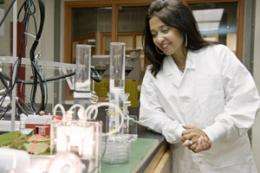What's Smelly But Can Fuel a Car?

Driving home from a seminar on fuel cell technology, Gerardine Botte was struck with a notion. Her idea was based on water electrolysis, a process used to produce hydrogen energy from water. Botte, an associate professor of chemical and biomolecular engineering in the Russ College of Engineering and Technology, took the concept to the next level: Instead of clean water, what if it were possible to use wastewater?
“You could remove the ammonia from wastewater, convert it to hydrogen energy, and it would be better, because you’d be remediating and producing clean energy,” says Botte.
What resulted was a first-of-its-kind fuel cell technology, known as the “ammonia electrolytic cell,” that allows hydrogen to be produced on demand. It’s an efficient and environmentally sound process; compared to water electrolysis, ammonia electrolysis consumes 95 percent less energy and produces more hydrogen.
The ammonia itself comes from a renewable supply. Botte estimates more than 5 million tons of ammonia enter the waste stream as human and animal urine each year in the United States.
If it seems like an unlikely fuel source, Botte will do her best to convince you otherwise. “I think ammonia is our future fuel,” she says. “It’s green, renewable, and we know how to transport it and work with it.”
Since its inception, Botte’s idea of ammonia electrolysis has blossomed into several projects. At Ohio University, she enlists the help of five graduate students who each cover specific branches of ammonia electrolysis research, including potential automobile and residential applications.
In November, Botte’s Electrochemical Engineering Research Laboratory received a $2.23 million federal grant to adapt the concept for military use. Under the “Silent Camp Initiative,” she’ll work with the U.S. Army Engineer Research and Development Center’s Construction, Engineering Research Laboratory to provide backup power for training facilities and soldier camps at night.
The system could cut long-term costs for fuel and decrease susceptibility to attacks against fuel supply lines.
If successful, there could be promising potential for the commercialization of the ammonia electrolytic cell.
Botte takes pride in the fact that the cell had its beginnings at Ohio University. “It was born here and is unique to this university,” she says.
Provided by Ohio University (news : web)

















